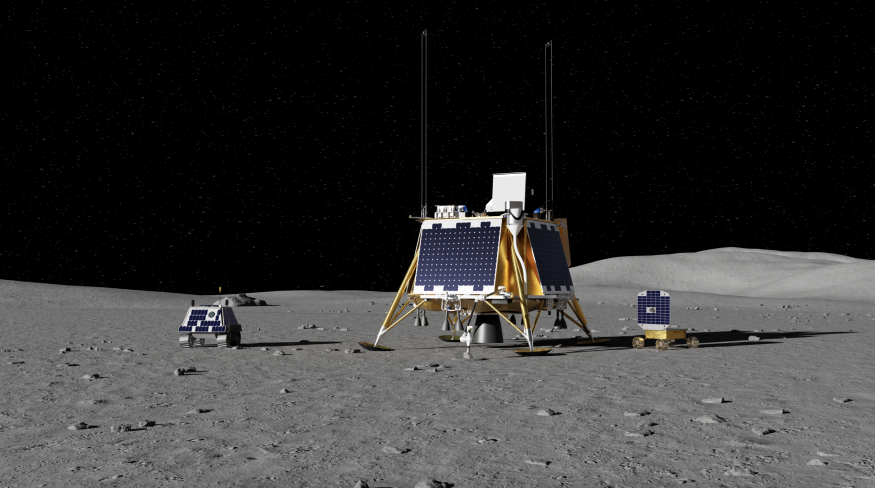
NASA has selected Firefly Aerospace to deliver a multi-payload campaign to the Moon's South Pole in 2029 under the Commercial Lunar Payload Services (CLPS) program. On July 29, 2025, NASA announced a $176.7 million task order that includes two rovers and three stationary instruments. The manifest features Carnegie Mellon University's MoonRanger micro-rover, a Canadian Space Agency rover, and instruments from NASA and the University of Bern. NASA notes this will be the first time it fields multiple rovers alongside stationary payloads in the region to study surface composition and operations near permanently shadowed areas. Firefly previously completed a lunar delivery in March 2025.
MoonRanger was developed by teams at CMU with Astrobotic and NASA Ames. The suitcase-sized rover will carry a neutron spectrometer to investigate hydrogen-bearing volatiles in regolith and will collect images and telemetry data while demonstrating autonomous capabilities for lunar polar exploration. It is designed to operate for one lunar day, about fourteen Earth days, using stereo vision and onboard compute to travel steadily between waypoints without teleoperation. CMU credits project leadership to research professor David Wettergreen, Founders University Research Professor Emeritus William "Red" Whittaker, and senior project scientist Heather Jones. CMU reports that updates and testing are underway in a campus clean room in preparation for delivery to Firefly.
The MoonRanger flight is part of a broader CMU effort that links robotics research, student training, and campus-based space mission operations. It builds on Iris, described by Forbes as the world's first nano lunar rover, which launched on January 8, 2024, aboard United Launch Alliance's Vulcan Centaur Rocket as part of Astrobotic's Peregrine Mission One, the first NASA CLPS launch carrying NASA scientific instruments and commercial payloads. Peregrine aimed to deliver the first U.S.-built lunar lander since Apollo 17 in 1972; after 10 days and 13 hours in space, the mission concluded with a controlled re-entry over the South Pacific Ocean.
CMU, widely regarded as a global leader in robotics, cybersecurity, and cloud computing, applies that expertise to secure, campus-based mission control. The work also draws on alumni with security and computing backgrounds. Among them is Harshvardhan Chunawala, an alumnus of CMU's Information Networking Institute and a cloud security technologist. He was an early contributor to establishing Carnegie Mellon Mission Control (CMMC), the campus command hub for CMU and national space missions. At the INI, he served as Space Missions Engineering Lead and, as a mission operator, commanded the Iris rover at lunar distance. CMMC houses the operations floor and a separate data room, with servers that power the main control room and a VPN connection to the landing companies that relay communications between CMU and lunar rovers. For Iris, that link was through Astrobotic. For MoonRanger, it will be through NASA's CLPS program. The facility is located in the Gates Center for Computer Science and supports current and future missions.
H. Chunawala is one of roughly 100 recipients worldwide of the AWS Golden Jacket, an award reserved for professionals who have completed all active AWS certifications. The first public ceremony for the award took place at AWS Summit Washington, DC 2025, where he appeared in a MoonRanger T-shirt, signaling CMU's continuing lunar work and his research interests at the intersection of cloud security and space systems. As reported in university materials, H. Chunawala identified ways for the INI to contribute to CMU's space missions and related cloud computing efforts, strengthening the security posture for space missions. Working with INI Director Dena Haritos Tsamitis and the Robotics Institute's David Wettergreen, he created cybersecurity-focused technical pathways for students and researchers. Through these practicum projects, INI students contributed to national space missions at CMU under NASA initiatives, including the Iris rover and the forthcoming MoonRanger mission, advancing core space systems and cloud security research.
NASA frames CLPS deliveries like Firefly's Blue Ghost Mission 4 as building blocks for Artemis science and technology. By fielding multiple rovers and instruments together at the south pole, the 2029 campaign is intended to generate data that informs resource prospecting, landing-site operations, and future crewed missions.
Taken together, CMU's robotics research with cyber-resilient Mission Control infrastructure, and alumni contributions, combined with partnerships across Firefly Aerospace, NASA centers, the Canadian Space Agency, Astrobotic, and the University of Bern, show how campus-built autonomy, secure ground systems, and commercial lunar logistics are coming together to support sustained lunar exploration.
© 2025 ScienceTimes.com All rights reserved. Do not reproduce without permission. The window to the world of Science Times.












